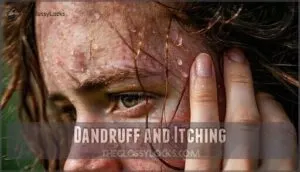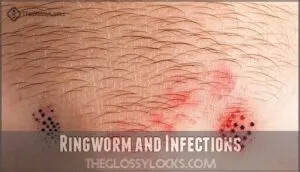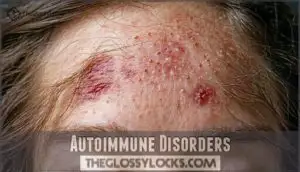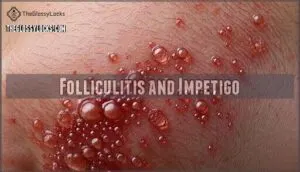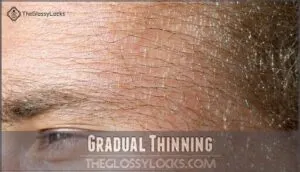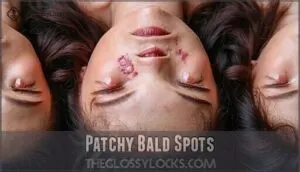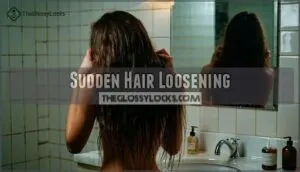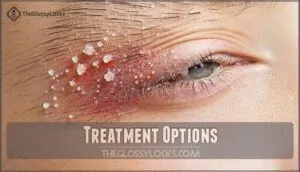This site is supported by our readers. We may earn a commission, at no cost to you, if you purchase through links.

Seborrheic dermatitis creates flaky, inflamed patches that weaken follicles.
Alopecia areata causes your immune system to attack hair roots, creating coin-sized bald spots overnight.
Fungal infections like ringworm spread quickly, leaving scaly patches in their wake.
Folliculitis inflames individual follicles, while scalp psoriasis builds thick, silvery scales that suffocate healthy growth.
Each condition disrupts your hair’s natural cycle differently, but they all share one thing: early recognition makes treatment more effective.
Understanding these warning signs could be the difference between temporary thinning and permanent loss.
Recognizing the conditions and their impact is crucial for effective management and minimizing damage, emphasizing the importance of hair’s natural cycle and the need for effective treatment.
Table Of Contents
- Key Takeaways
- Hair Loss Causes
- Scalp Conditions
- Hair Loss Symptoms
- Treatment Options
- Prevention Methods
- Frequently Asked Questions (FAQs)
- What scalp condition can cause hair loss?
- Is there a scalp fungus that causes hair loss?
- What autoimmune disease causes scalp issues?
- What does autoimmune hair loss look like?
- Can hair loss from scalp conditions be reversed?
- How long does recovery take after treatment?
- What early warning signs should I watch for?
- Are there natural remedies for scalp-related hair loss?
- When should I see a dermatologist immediately?
- Conclusion
Key Takeaways
- Early detection makes the difference – You’ll prevent permanent damage by recognizing warning signs, such as sudden patchy baldness, persistent itching, or unusual scaling, before conditions progress too far.
- Multiple conditions share similar symptoms – Whether you’re dealing with seborrheic dermatitis, alopecia areata, or fungal infections, they all disrupt your hair’s natural growth cycle and require different treatment approaches.
- Treatment works best when started quickly – You can reverse hair loss from most scalp conditions if you act fast, but waiting often leads to scarring and permanent follicle damage that won’t regrow.
- Professional help beats guesswork – You shouldn’t self-diagnose scalp conditions, since proper identification determines whether you need antifungals, immune therapies, or other specific treatments for your particular situation.
Hair Loss Causes
Hair loss doesn’t just happen overnight—it stems from various underlying causes that affect your scalp and hair follicles.
Understanding these root causes helps you identify the right treatment approach and take steps to protect your remaining hair.
Hereditary Factors
Your genetic blueprint determines whether you’ll face hair loss later in life.
Your DNA holds the blueprint for your hair’s future – check your family tree for clues.
Androgenetic alopecia, the most common form of hereditary hair loss, affects both men and women through inherited traits from either parent.
Family history of male pattern baldness or female pattern baldness substantially increases your risk.
These baldness genes create a genetic predisposition that influences when and how severely hair thinning occurs, making heredity the primary factor in most hair loss cases, which is linked to androgenetic alopecia.
Hormonal Imbalances
Your hormones act like traffic controllers for hair growth, and when they’re out of balance, hair loss often follows.
Androgen excess from PCOS impact can trigger male-pattern baldness in women, while thyroid disorders disrupt your hair’s natural cycle.
Postpartum loss affects new mothers as estrogen levels drop, and menopause hair changes reflect declining hormones that once protected your locks, related to hormone imbalance and hair growth issues.
Medical Conditions
Several medical conditions can trigger hair loss beyond what you’d expect from normal aging.
Thyroid disorders throw your body’s metabolism off balance, while autoimmune diseases like lupus attack your own hair follicles.
Nutritional deficiencies rob your scalp of essential building blocks, and scalp infections create inflammation that disrupts healthy growth patterns.
Addressing these issues often requires focusing on overall scalp health, which is crucial for healthy growth patterns, scalp infections, and maintaining overall scalp health.
Aging and Stress
As you age, your hair follicles naturally slow down, and chronic stress elevates cortisol levels, triggering telogen effluvium.
This oxidative stress damages dermal papilla cells, causing premature senescence and reduced hair growth.
Managing stress through relaxation techniques can help minimize hair loss and maintain healthier scalp conditions as you get older, which can lead to a reduction in oxidative stress.
Scalp Conditions
Your scalp’s health directly impacts your hair’s ability to grow and thrive, and several common conditions can disrupt this delicate balance.
When infections, inflammation, or autoimmune responses target your scalp, they can damage hair follicles and lead to temporary or permanent hair loss.
Dandruff and Itching
Those pesky white flakes aren’t just embarrassing—they’re actually sabotaging your hair.
Dandruff causes scalp inflammation that weakens hair follicles, while constant scratching from itchy scalp hair loss creates mechanical damage.
Seborrheic dermatitis and product sensitivity worsen the cycle, turning minor dandruff hair loss into noticeable thinning through chronic irritation.
Effective solutions often involve using dandruff control products to manage symptoms.
Scalp pruritus is common, with approximately 25% experiencing it in the general population, leading to itchy scalp hair loss and chronic irritation.
Ringworm and Infections
Fungal scalp infections like ringworm create circular bald patches with scaling and broken hairs.
These hair loss scalp conditions spread through direct contact or shared items like combs and hats. The infection is often caused by dermatophytes, a type of fungus.
Key infection diagnosis signs include:
- Black dot pattern – hairs break at scalp level
- Gray patch appearance – hairs snap above skin surface
- Scaling and redness around affected areas
Ringworm requires oral antifungals for treatment efficacy, as topical medications can’t penetrate deep enough. Without proper contagion control and early intervention, severe cases may progress to kerion, risking permanent scarring alopecia that won’t regrow.
Autoimmune Disorders
Your immune system can turn against your hair follicles, causing autoimmune disorders like Alopecia Areata and Lupus Erythematosus.
These conditions create patchy hair loss when your body mistakenly attacks healthy follicles.
Hashimotos Disease affects thyroid function, disrupting hair growth cycles.
Psoriasis Impact includes scalp inflammation leading to hair loss, while Discoid Lupus creates permanent scarring.
Immune Therapies help manage these autoimmune skin diseases effectively, including conditions like Lupus Erythematosus, and can be crucial for treating autoimmune disorders.
Folliculitis and Impetigo
Between scalp bumps and bacterial infections, folliculitis and impetigo create a perfect storm for hair loss.
Folliculitis causes follicle inflammation when bacteria invade hair roots, while impetigo spreads contagious sores across your scalp.
Both conditions carry contagion risk and scarring potential.
Treatment efficacy improves with early antibiotic intervention, preventing permanent folliculitis hair loss.
Hair Loss Symptoms
Hair loss symptoms can vary dramatically depending on the underlying scalp condition affecting your follicles.
You might notice gradual thinning, sudden patches of baldness, or even complete hair loss that signals a specific medical issue requiring targeted treatment.
Gradual Thinning
Over time, you’ll notice your hair’s density changes as strands become thinner and weaker.
Hairline recession typically starts at the temples, while part widening becomes more noticeable.
These miniaturization signs indicate follicles are shrinking, producing finer hair before eventually stopping growth altogether—classic markers of gradual thinning from scalp conditions, which are signs of gradual thinning.
Patchy Bald Spots
Unlike gradual thinning, patchy bald spots appear suddenly as circular areas where hair vanishes completely.
Alopecia areata, an autoimmune condition, attacks hair follicles and creates these distinct bare patches on your scalp.
You’ll notice smooth, coin-sized spots that may feel slightly tender or itchy.
Fungal infections can also trigger patchy hair loss with accompanying scalp inflammation and redness.
Alopecia areata is a key factor in the development of these bare patches.
Sudden Hair Loosening
After experiencing triggering events like surgery, illness, or emotional trauma, you might notice sudden hair loss called telogen effluvium.
This shock loss creates diffuse thinning across your entire scalp, not just specific areas.
Hair follicles enter a resting phase prematurely, causing noticeable shedding within two to three months.
The good news? Your recovery timeline typically spans six to twelve months once the underlying stressor resolves, which is a critical aspect of managing hair loss.
Full-Body Hair Loss
Complete hair loss across your body can feel overwhelming, but understanding the causes helps you navigate treatment options.
This condition, called alopecia universalis, affects every hair follicle and stems from various triggers.
Here are four main causes of full-body hair loss:
- Chemotherapy Effects – Cancer treatments target rapidly dividing cells, including hair follicles, causing temporary but complete alopecia
- Autoimmune Alopecia – Your immune system mistakenly attacks hair follicles throughout your body, leading to alopecia areata progression
- Systemic Illnesses – Severe autoimmune disease, thyroid disorders, or nutritional deficiencies can trigger telogen effluvium affecting all body hair
- Emotional Trauma – Extreme stress disrupts normal hair cycles, potentially causing widespread hair loss patterns
Treatment Options
When you’re dealing with scalp conditions that cause hair loss, you have several treatment paths to explore.
Your options range from proven medications like minoxidil and finasteride to advanced procedures such as hair transplants and laser therapy.
Medications and Supplements
Several medications can help restore your hair’s natural growth cycle.
Minoxidil, available over-the-counter, requires twice-daily application and shows results within four to twelve months.
Finasteride works by blocking DHT hormone production in men.
Supplement efficacy varies—iron, zinc, and biotin address nutritional deficiencies effectively.
Effective hair regrowth can be achieved with consistent use of certain products.
Long-term usage remains necessary for sustained benefits, as discontinuation typically reverses progress, highlighting the importance of consistent use and understanding the role of hair growth.
Hair Transplant Surgery
Hair transplant surgery moves healthy hair follicles from donor areas to balding spots using advanced surgical techniques.
Graft survival depends on proper handling and placement during the recovery process, while potential risks include infection and scarring.
Most patients see natural hair regrowth within months, and Follicular Unit Extraction offers precise placement with minimal scarring.
Long-term results from hair restoration procedures typically last years when performed by experienced surgeons.
Low-Level Laser Therapy
Low-level laser therapy uses red light wavelengths to stimulate your hair follicles at the cellular level.
LTLT effectiveness varies, but studies show modest hair growth improvements over several months.
You’ll find FDA-approved home devices offering convenient therapy duration of 20-30 minutes daily, with laser safety profiles remaining excellent and minimal side effects.
Future research continues exploring ideal light therapy protocols for various scalp conditions.
Platelet-Rich Plasma Injections
Platelet-rich plasma therapy offers a promising approach when other treatments haven’t delivered the results you’re hoping for.
Your own blood gets processed to concentrate healing platelets, which are then injected into your scalp to stimulate dormant follicles.
Consider these benefits of PRP effectiveness:
- Natural healing using your body’s own growth factors
- Minimal side effects since it’s your own blood
- Long-term results that improve hair density over time
The injection technique involves drawing your blood, spinning it in a centrifuge, then carefully injecting the concentrated platelets into thinning areas.
Treatment cost varies but many find the investment worthwhile for scalp treatment that can slow hair loss progression.
Prevention Methods
While you can’t always prevent scalp conditions, you can substantially reduce your risk with proper care habits.
Focus on gentle hair handling, good nutrition, stress management, and regular scalp maintenance to keep your hair and scalp healthy.
Gentle Hair Care
Beyond medical treatments, protecting your hair starts with simple daily habits.
Treat your strands like delicate fabric that needs gentle handling to maintain its strength and appearance.
| Gentle Technique | Protective Benefit |
|---|---|
| Wide-Toothed Combs | Reduces breakage and tangles |
| Soft Brushes | Minimizes scalp irritation |
| Silk Scarves | Prevents friction during sleep |
| Hydrating Shampoos | Maintains moisture balance |
| Avoid Tugging | Protects hair follicles |
Your hair care routine directly impacts scalp health and hair loss prevention.
Use gentle motions when washing and styling.
Consider using specialized detangling tools for fragile hair.
Choose products designed for your specific scalp conditions, and remember that consistency beats intensity when nurturing healthy hair growth.
Balanced Diet and Nutrition
Nourishing your body properly can prevent hair loss and nutrition-related scalp health issues.
Focus on Vitamins for Hair like biotin, iron, and zinc through lean meats, leafy greens, and nuts.
Adequate Protein Intake supports keratin production, while addressing Mineral Deficiencies strengthens follicles.
Don’t forget Hydration Effects and Gut Health—both impact nutrient absorption for maximum diet benefits.
Reducing Stress and Chemical Exposure
Why let stress and harsh chemicals sabotage your hair growth? Managing daily pressures and choosing gentler products can substantially reduce hair loss while promoting scalp health.
- Practice stress reduction techniques like meditation, exercise, or deep breathing to lower cortisol levels
- Avoid chemical avoidance by steering clear of harsh dyes, perms, and bleaching treatments
- Choose gentle products with sulfate-free shampoos and natural ingredients for daily hair care
- Schedule regular scalp detox sessions using clarifying treatments to remove buildup
- Implement lifestyle changes including adequate sleep, regular exercise, and avoiding tight hairstyles
To further promote hair health, consider biotin rich foods in your diet to support overall well-being and reduce hair loss.
Regular Scalp Care and Check-Ups
Regular scalp care and professional checkups create your first line of defense against hair loss.
Schedule annual scalp check-ups with a dermatologist for early detection of scalp conditions.
At home, practice gentle scalp exfoliation weekly and choose sulfate-free products.
Home remedies like tea tree oil can supplement professional care, but don’t replace expert evaluation when concerns arise, ensuring you receive proper professional care.
Frequently Asked Questions (FAQs)
What scalp condition can cause hair loss?
Several scalp conditions can trigger hair loss.
Alopecia areata causes patchy bald spots, while seborrheic dermatitis and psoriasis create inflammation that damages follicles.
Fungal infections like ringworm also disrupt healthy hair growth patterns.
Is there a scalp fungus that causes hair loss?
Fungal infections affect 3-4% of the population annually. Yes, ringworm (tinea capitis) is a common scalp fungus that causes patchy hair loss, scaling, and broken hair shafts, particularly in children.
What autoimmune disease causes scalp issues?
Alopecia areata is the main autoimmune disease you’ll encounter that targets your hair follicles.
It creates circular bald patches on your scalp and can spread to affect your eyebrows and beard too.
What does autoimmune hair loss look like?
Ironically, autoimmune hair loss that attacks your own follicles creates distinct circular or patchy bald spots on your scalp, beard, or eyebrows, sometimes with itchy, painful areas.
Can hair loss from scalp conditions be reversed?
Hair loss from treatable scalp conditions like infections, inflammation, or dermatitis can often be reversed with proper treatment.
However, scarring conditions may cause permanent damage, making early intervention essential for your best recovery chances.
How long does recovery take after treatment?
Recovery time varies widely depending on your specific condition and treatment type. Most treatments take 3-6 months to show results, often requiring multiple sessions for maximum improvement.
What early warning signs should I watch for?
Watch for gradual thinning, receding hairlines, circular bald patches, sudden hair loosening after stress, excessive daily shedding beyond 100 hairs, scalp itching, redness, or scaling that persists.
Are there natural remedies for scalp-related hair loss?
Several natural remedies can help with scalp-related hair loss.
Try gentle scalp massages with essential oils like rosemary or peppermint, which improve circulation.
Green tea rinses, aloe vera, and biotin-rich foods also support healthy hair growth naturally.
When should I see a dermatologist immediately?
See a dermatologist immediately if you experience sudden, severe hair loss, painful or inflamed scalp areas, signs of infection, or suspicious growths that could indicate serious conditions.
Conclusion
Ironically, your hair’s worst enemies often masquerade as minor scalp irritations you’d typically ignore.
These scalp conditions causing hair loss don’t announce themselves with dramatic fanfare—they whisper through subtle itching, flaking, or small bald patches.
You’ll notice gradual changes before sudden, irreversible damage occurs.
Early intervention transforms potential permanent loss into manageable treatment scenarios, which is why early intervention is crucial, and it’s essential to take action when you spot warning signs, because your hair’s future depends on today’s action, and waiting can lead to irreversible damage, so it’s vital to Consult a dermatologist when you spot warning signs to prevent serious damage.

